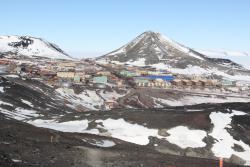
October 23, 2016
U.S. Antarctic Program Investigator Perishes in Snowmobile Accident
A researcher with the U.S. Antarctic Program (USAP(abbreviation) United States Antarctic Program), managed by the National Science Foundation (NSF), suffered a fatal injury on Saturday, October 22, New Zealand time. Dr. Gordon Hamilton, University of Maine Climate ChangeA statistically significant variation in either the mean state of the climate or the mean variability of the climate that persists for an extended period (typically 10 years or more). Climate change may result from such factors as changes in solar activity, long-period changes in the Earth's orbital elements, natural internal processes of the climate system, or anthropogenic forcing (for example, increasing atmospheric concentrations of carbon dioxide and other greenhouse gases). Institute, Orono, Maine, was fatally injured when the snow machine he was riding went into a crevasse. Hamilton’s team was camped in a heavily crevassed area known as the Shear Zone (SZ), approximately 25 miles south of McMurdo Station, the largest of the three U.S. research stations in Antarctica. The McMurdo SZ is a 3 mile wide and more than 125 mile long swath of intensely crevassed ice where the Ross Ice Shelf meets the McMurdo Ice Shelf. The ice is up to 650 feet thick in this area. Dr. Hamilton’s body has been recovered and will be returned to his family in Maine. An accident investigation has begun by USAP(abbreviation) United States Antarctic Program personnel. “I am deeply saddened by the news of the tragic death of Dr. Hamilton. Our thoughts are with the family and entire community as we mourn this loss” said Dr. France Córdova, Director, National Science Foundation. Dr. Hamilton’s research utilized two robots that contained ground penetrating radar instruments to study the stability of the Ross and McMurdo Ice Shelves.
At the time of the accident, the science team was camped approximately 200 yards from the USAP(abbreviation) United States Antarctic Program’s South Pole Operations Traverse crevasse remediation team. The two teams, science and Traverse operations, were working together to identify and remediate crevasses which had appeared in the past year.
The two teams included experienced personnel who had worked in this area over the past several years and all members of both teams had received crevasse and glacial safety training before going into the area. In addition, mountaineers, familiar and experienced with the SZ, were with each of the two teams. Crevasses had been identified and filled earlier in the week and work on a newly identified crevasse was beginning at the time of the accident. The NSF manages the USAP(abbreviation) United States Antarctic Program, through which it coordinates all U.S. research and the necessary logistical support on the continent and aboard ships in the Southern Ocean.
NSF Media Contact: Peter West: 301-385-7140


Comments